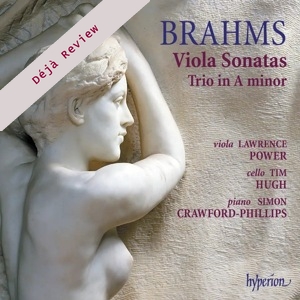
Déjà Review: this review was first published in May 2007 and the recording is still available.
Johannes Brahms (1833-1897)
Sonata for Viola and Piano in F minor, Op. 120 No. 1 (1894)
Trio for Viola, Cello and Piano in A minor, Op. 114 (1891)
Sonata for Viola and Piano in E flat Major, Op. 120 No. 2 (1894)
Lawrence Power (viola); Tim Hugh (cello); Simon Crawford-Phillips (piano)
rec. 2006, Wathen Hall, St. Paul’s School, Barnes, London
Hyperion CDA67584 [65]
In an Indian summer of creativity near the end of his career, Brahms wrote the Trio for clarinet (viola), cello and piano, Op. 114 (1891); the Quintet for clarinet (viola) and strings, Op. 115 (1891) and two Clarinet (Viola) Sonatas, Op. 120 (1894). All the scores were composed especially for Richard Mühlfeld, the popular virtuoso clarinettist whose playing had been an inspiration to the aging Brahms. To ensure the widest possible circulation for these four scores Brahms transcribed the clarinet part for the viola; the versions are virtually identical. It is with these chamber works that Brahms bids a permanent farewell to chamber music
The two Viola Sonatas, Op. 120 were composed in the summer of 1894 at Bad Ischl in Upper Austria. The small resort was an extremely popular holiday destination in Brahms’s time and the summer capital of the great Austro-Hungarian monarchy, an association with the Habsburg imperial court that had continued for at least 700 years.
The Viola Sonata in F minor, Op. 120 No. 1 opens pessimistically but gathers strength and hope as the music progresses to a triumphant end. Throughout one cannot help but be impressed with the partnership of Power and Crawford-Phillips, strongly sensing their innate emotional involvement. They expertly convey the essential elements of storminess and melancholy that permeate the work.. The dramatic quality of the opening Allegro appassionato is strongly emphasised and the second movement is pensive with an unsettling feeling of introspection and searching. Here Power’s expressive playing is charismatic: relaxed and unaffected. The duo provide just the right degree of lightness and grace in the restrained Allegro grazioso where the mood alternates between grace and a peasant-like earthiness. In the high spirited Vivace finale I especially enjoyed how the players approach the music with verve and exuberance as they hasten towards the joyous conclusion.
The Viola Sonata in E flat Major, Op. 120 No. 2 has an unusual structure and ends with a slow movement that bids farewell to Brahms as a chamber music composer. Power’s lyricism is unfailingly expressive and the piano playing Crawford-Phillips is durable and highly supportive. The opening Allegro amabile has been called a masterpiece of seamless construction and has a convincing autumnal quality that this partnership memorably reveals. The Scherzo has a brusque and reckless character with playing from Power of a stormy intensity that accentuates the passionate and unyielding nature of the movement. In the finale the gently rocking Andante con moto takes the form of a theme and variations. From 4:36 the concluding Allegro non troppo is performed with high spirits in what is a remarkably convincing display of musicianship.
There is strong competition in the catalogues for recordings of the two Viola Sonatas. These Hyperion performances would not be my first choice, although I regard them highly and they are well worth adding to any serious Brahms collection. My recommendation would be the sweet and Romantic accounts from the dream-team partnership of Pinchas Zukerman and Daniel Barenboim on a Deutsche Grammophon double set DG 289 453 121-2 (c/w Violin Sonatas 1-3 and FAE Scherzo). For their spontaneous feel and natural flow I can also suggest the 2003 Berlin recordings from Shlomo Mintz and Itamar Golan on a double from Avie Records AV2057 (c/w Violin Sonatas 1-3 and FAE Scherzo).
The Trio for Viola, Cello and Piano in A minor, Op. 114 was composed in the summer of 1891 and like the two Viola Sonatas also at the resort of Bad Ischl. Brahms’s alternative arrangement for the viola from the original clarinet part was undertaken upon its publication the following year. The A minor Trio has never attained the popularity of the Quintet, Op. 115 although it has a wider emotional scope and is often considered more challenging to perform.
The opening movement is an Allegro of aching passion performed here with wide extremes of intensity, contrasted with a convincing tenderness. In the hands of this talented trio the gentle and feminine Adagio is communicated with a quality of unforced approachability. The Andantino grazioso is interpreted in a lyrical, even tempered way with especially cheerful waltz episodes. The high passions of the opening movement return in the closing Allegro. It feels as if the component instruments are conducting an intense three-way conversation that ranges from hearty laughter to the merest whisper.
There are several versions of the Clarinet Trio, Op 114 in the catalogues and far less of the viola arrangement. The recording of the Viola Trio most likely to be encountered, although not one that I am familiar with, is the 1989 Moscow performance from star soloists: Yuri Bashmet; Natalia Gutman and Christoph Eschenbach on the Live Classics label LCL 204 (c/w Cello Sonatas, Opp. 38, 99). However, given the excellence of the present performance from Power; Crawford-Phillips and Hugh there would seem little point in looking elsewhere.
All three scores were recorded by Hyperion at St. Paul’s School in London and the engineers have closely caught the players in a slightly cramped acoustic, revealing some over-bright forte passages. The booklet notes from Brahms biographer Malcolm MacDonald are as authoritative as we have come to expect. In short this is an excellently performed recording of three attractive Brahms chamber scores.
Michael Cookson
If you purchase this recording using a link below, it generates revenue for MWI and helps us maintain free access to the site



















